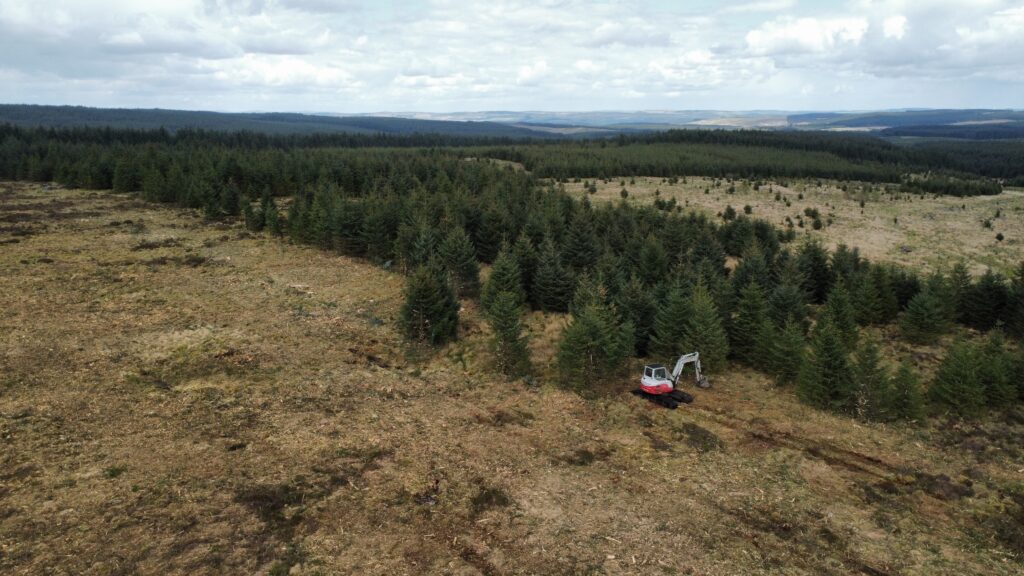TreeClear is the UK’s leading company for removing vegetation from peatland sites.
Get in touch with us today to discuss your project and requirements. Contact the office on 01772 783322 or mobile 07813 140683 or use our online contact form to register your enquiry.
Peatland Restoration – How We Help
Treeclear UK provide peatland restoration in Lancashire, Cumbria, Cheshire, Yorkshire, Northumberland & Co Durham.
We also cover Nottinghamshire, Lincolnshire, and Cambridgeshire.
A combination of purpose-built low ground pressure excavators & unique mulching heads enables us to tackle various types of vegetation on virtually any peatland surface.
Our low ground pressure excavators only exert 1.5 psi enabling us to travel over most terrains with minimal damage enabling the ground to quickly recover. The working width is 15 m per pass minimising the area tracked over to less than 15% of the area worked.
- Dense scrub such willow and rhododendron
- Regenerated birch and pine
- Failed softwood plantations
- Unwanted woody vegetation
Get in touch with us today by calling us at 07813 140 683 or use our online contact form.
With various attachments such as tree shears, drum mulchers, timber grabs and stump grinders, our LGP excavators are extremely versatile. Every project is different, and we take pride in working closely with every client to achieve their ultimate objective.
Once the vegetation clearance is complete, we can also assist in a range of peatland restoration techniques to bring the whole project together.
- Habitat creation
- Re-profiling of ditches
- Ditch blocking
- Pond and scrape creation
- Bunding and rewetting
Treeclear UK provide the following sub-services as part of peatland restoration:
Surface Mulching
Surface mulching is a vital technique in peatland restoration that helps to invigorate the surface of the peat and promote the growth of native vegetation. Surface mulching allows old woody vegetation such as heather to be chopped up into small pieces adding a protective barrier on the peat surface, positively contributing towards the health of the area by adding organic matter. As well as enhancing the overall functionality of the peatland area, surface mulching can also create various micro habitats enabling dormant plants and mosses to recolonise an area.
Stump Grinding & Stump Augering
Stump grinding and stump augering can play a big part in certain peatland restoration projects and is particularly beneficial in forest to bog projects. Using highly specialised equipment, stump grinding is carried out using a low ground pressure excavator with a hydraulic grinding wheel attachment to remove stumps down to or below ground level. Stump augering takes a different approach that involves removing the stump using a large hydraulic slow speed corkscrew type of attachment. Both systems are normally adopted when access is required and bunding works need to be performed in an area previously covered with trees.
Ditch Blocking and Peat Dams
The purpose of ditch blocking and peat dams is to prevent water from flowing out of a site. Peat bunds and ditch blocks help in stemming the flow of water that runs off site down existing ditches or drainage channels. By disrupting flow patterns, retaining water on site and re-establishing wet conditions encourages peatland ecosystems to thrive. Effective ditch blocking and peat dam construction are key to reversing the impacts of drainage and water run off helping the long-term success of a restoration process.
Reprofiling and Bunding
Reprofiling and bunding are important techniques that are used in the process of the restoration of damaged or degraded peatlands. Reprofiling involves reshaping the land surface for restoration purposes and to improve overall water retention.
Ditching and Bunding, on the other hand, involves digging ditches through the dry surface peat, creating a barrier so underground water cannot penetrate it and forming a raised bund at the surface to help raise the water level across the site.
Deep ditch bunds are normally used around the perimeter of a site to retain water within the designated area. Cell bunds are created to form a mosaic of small reservoirs in which to retain and raise the water table with the site. Both of these bunding techniques are essential for the long-term recovery of our precious peatlands.



